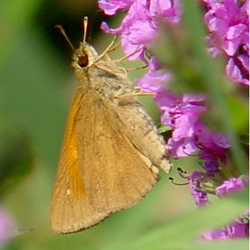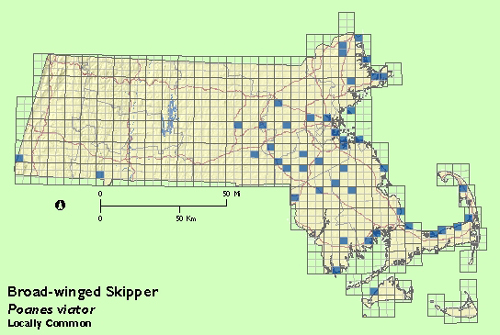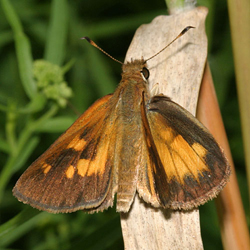Find a Butterfly
Broad-winged Skipper
Poanes viator
Named
Edwards, 1865

Identification
Wingspan 1 1/4 - 1 3/4". Robust and broad-winged. Dark brown forewings above, with rectangular orange (male) or yellowish-white (female) spots. Hindwings above orange with wide dark brown borders. Hindwings below tawny, with median band of rectangular yellowish or whitish spots, next to uppermost lengthened into streak. No stigma in male.
Distribution
Discontinuous range through eastern North America. The "inland" subspecies ranges from southeastern Manitoba east to western New York: also, Nebraska. The "coastal" subspecies ranges from Massachusetts south along the Atlantic coastal plain to northern Florida and along the Gulf coast to eastern Texas. Most of the midwest and mid-South are outside the species‘ range. Opler and Krizek (1984) note that "Careful biological and ecological studies may reveal that the inland and coastal populations consist of separate sibling species." In New England, the Broad-winged Skipper ranges at least as far north as the northern border of Massachusetts, and probably to coastal New Hampshire.
Status in Massachusetts
Largely unreported from Massachusetts prior to the Atlas survey; Scudder listed two 19th century specimens from Holyoke. During the Atlas, the species was widely reported from eastern Massachusetts, with two western Massachusetts records. Broad-winged Skippers occur in association with invasive grass Common Reed (Phragmites australis), and appear to be expanding inland with the spread of Phragmites. Colonies may be isolated from one another by many miles. The nature of the preferred habitat (dense stands of 6‘ - 12‘ grass) makes counting populations difficult, but where found, the species is often common. Maximum: 62 on 28 July 1991, Worcester - BMBWS (Worcester Co.), in one reed stand.

Flight Period in Massachusetts
The single brood flies from mid-July to late August. Extreme dates: 12 July 1989, Orleans (Barnstable Co.), B. Cassie and 30 August 1987, Plum Island (Essex Co.), B. Cassie.
Larval Food Plants
Common Reed (Phragmites australis) is the preferred food plant in Massachusetts, though the species is also known to feed on Wild Rice (Zizania aquatica) .
Adult Food sources
Purple Loosestrife and Joe-Pye-Weed are often recorded.

Habitat
Fresh water and brackish wetlands that have been invaded by Common Reed Stands as small as 30‘ x 15‘ are used but larger ones are preferred. It may be found at flowers a considerable distance from reeds.
Life Cycle
EGG: Gray. OVIPOSITION: Unrecorded. LARVA: Gray, turning brown with maturity. PUPATION: Unrecorded. CHRYSALIS: Unrecorded. OVERWINTERING STAGE: Unrecorded.
Not a great deal is known about the life history of the Broad-winged Skipper. Adults weave their way through the Phragmites with a slow, bouncing flight and do not make their annual appearance until late summer. Broad-winged Skippers are found in greatest numbers within the Phragmites stands. A sizable population, slowly meandering through the reed stalks and keeping within the sanctuary of the reed bed, may be virtually invisible to the casual observer. Small numbers wander widely, presumably in search of nectaring plants, and help populate widely-separated Phragmites colonies. Reasonably large populations of Broad-winged Skippers occur in eastern Massachusetts. Their study would be a worthwhile, and long overdue, contribution to the butterfly literature.
Account Author
Brian Cassie



